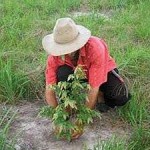
Dr. Jan Henning Sommer is a researcher at the Nees Institute for Biodiversity of Plants, University of Bonn, Germany, focusing on macroecology, biogeography, and conservation biology in the context of climate change. He is particularly interested in a better understanding of the processes responsible for the distribution of species ranges and biodiversity patterns, and on the possible impact of climate change and landuse on biodiversity. In the frame of the BIOTA-Africa project network funded by the German Federal Ministry of Education & Research, he is involved in the analysis of the African biodiversity and the development of sustainable, climate change and landuse-integrated conservation concepts. (Click here for detailed profile.)
In the coming decades, climate change is set to produce worldwide changes in the living conditions for plants, whereby major regional differences may be expected to occur. Thus, today´s cool, moist regions could in future provide habitats for additional species, and in hot regions, the climatic prerequisites for a high degree of plant diversity will deteriorate.
This is the conclusion reached in a new study by scientists at the Universities of Bonn, Göttingen and Yale, and publish in the Proceedings of the Royal Society B of London. The study was funded by the Academy of Sciences & Literature Mainz and the German Federal Ministry for Education & Research (BMBF).

Dr. Jan Henning Sommer of Bonn University’s Nees Institute for Biodiversity of Plants, asserts, “Climate change could bring great confusion to the existing pattern of plant diversity, with scarcely predictable consequences for our ecosystems and mankind.” The potential impact of climate change on global plant diversity has now, for the first time, been quantified and modeled on a regional basis. The researchers have investigated the numbers of plant species to be found in different regions under current climatic conditions, and the subsequent interrelationship they uncovered has now been applied to 18 different climate change scenarios for the year 2100.
However, the study does not permit any predictions regarding the degree to which the biodiversity of any given region will, in fact, adapt to new conditions or, in other words, whether additional species will migrate into favoured regions, or whether disadvantaged areas will in reality suffer mass losses of species. “That would be fortune-telling. The adaptability of species and their interactions in the ecosystem can, like human landuse, exert great influence on their distribution. This is a field about which we still know far too little,” Dr. Sommer explains. Nevertheless, the publish results do provide an important pointer to the likelihood of the scales of immigration or losses to be expected in given areas.
Globalization in the Plant Kingdom
It is possible that the worst effects of global warming on plant species numbers could be felt in the tropical Amazonian rain forests in South America. For Germany and other temperate regions worldwide, on the other hand, scientists are expecting future climatic conditions which will promote the provision of habitat space for an increased number of species. “But this can scarcely be described as a gain as the intensified redistribution of plant species will promote worldwide uniformity in the regional composition of species at the expense of unique species which have adapted to special habitat conditions,” says Sommer. And as a result, globalization would also come to the plant kingdom.
In their study, the researchers have emphasized the clear division of our planet into two parts as regards the impact of climate change on plant diversity. “Additional capacity for plants species richness could be created everywhere where today cool and moist climatic conditions prevail,” says Dr. Holger Kreft, the young research scientist from Bonn and co-author of the study, who has meanwhile assumed an appointment as junior professor at Göttingen University. “On the other hand, in areas which today have a hot tropical or sub-tropical climate the prerequisites for high species numbers will deteriorate.”

The Main Originators of Climate Change Less Affected
This division also has a political dimension: favoured areas coincide largely with the industrialized nations, who are responsible for the majority of global warming due to their high amount of greenhouse gas emissions. The study also points clearly to the consequences of a half-hearted climate policy. Should the global temperature rise by 1.8°C with respect to the year 2000, then the proportion of favoured and disadvantaged regions in terms of species richness would still remain in balance. “Even if the climate protection goals agreed in Copenhagen are achieved, we would still tend to be heading for a rise in temperature of up to 4°C,” says Sommer. In this case, the projected losses of capacity for plant species richness would considerably exceed possible gains in other regions.
“Politicians throughout the world should be paying greater attention to the impact of climate change on biodiversity as this is the basis of our human existence,” demands Professor Dr. Wilhelm Barthlott, Director of the Nees Institute and co-author of the study. He and his study group have been investigating global plant diversity for 15 years. Barthlott welcomes the fact that the United Nations has declared 2010 to be the year of biodiversity. “This was an important signal!”
Notes:
Title of the Study: “Projected Impacts of Climate Change on Regional Capacities for Global Plant Species Richness”
Authors: Jan Henning Sommer, Holger Kreft, Gerold Kier, Walter Jetz, Jens Mutke and Wilhelm Barthlott
Full Report publish at URL: http://rspb.royalsocietypublishing.org/content/early/2010/03/20/rspb.2010.0120.full.pdf













